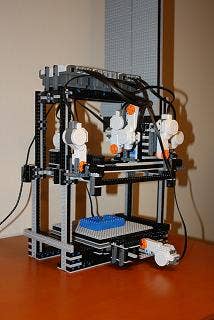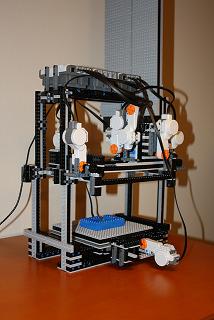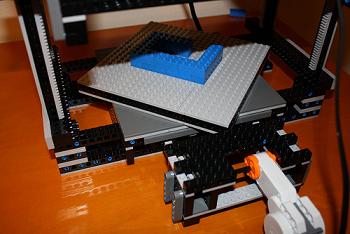Lego NXT 3D Printer: Use Blocks to Build Blocks (video)

Share
Following in the likes of MakerBot and RepRap, Will Gorman at BattleBricks has created a new 3D printer that you can build yourself. There's only one caveat: it's made of Lego. The MakerLegoBot is constructed from more than 2400 Lego blocks, including 3 NXT bricks, and 9 motors. With design files created using MLCad, the Lego printer can build any shape out of a variety of blocks (1x2 to 8x2) up to 12 layers high. It will be on display at LegoWorld in the Netherlands all this week, and Gorman has shared detailed instructions for how you can build your own. While the MakerLegoBot hasn't mastered the art of self replication yet, it is pretty cool to watch in action. Check it out in the video below. Make sure to stay tuned until the end to catch some cute stop-motion animation.
Seeing the MakerLegoBot create a house out of Lego makes my inner child pretty excited. Objectively I know that this 3D printer isn't even in the same field as MakerBot or RepRap, let alone the professional industrial models. Heck, any of those printers could make the Lego blocks themselves, maybe even print out the parts for the MakerLegoBot as a whole. Yet there's just something really cool about watching the toys from my childhood build themselves. The MakerLegoBot is the machine I thought about creating when I was seven. Little did I know it would require thousands of blocks and months of work to complete.
Be Part of the Future
Sign up to receive top stories about groundbreaking technologies and visionary thinkers from SingularityHub.


The crux of the Lego 3D printer is the axle based release system that Gorman designed. According to the MLCad file inputed into the device, the MakerLegoBot selects which of the differently sized blocks should be placed where in each layer. After depositing the selected block, the printer head tamps down on the brick to make sure it sits properly. Even a little inaccuracy in placing the block can screw up the entire print, so Gorman was very careful in making sure that each brick would be placed securely. A rotating base gives an additional degree of freedom in how blocks are situated, and the platform moves vertically to make room for the next layer. It's a pretty amazing simulation of a real 3D printer, and it makes Lego houses! How much more could you want?
Realistically, I'm not sure if MakerLegoBot is simply a glee-inducing model of a 3D printer, or if its creation pushes beyond mere novelty. The continuing stream of Lego NXT Mindstorms projects we see is evidence that the medium is a powerful tool for learning about and mimicking more advanced robotics. But will it ever be more than just a playground for students and amateur engineers? (In this case calling Gorman an amateur is inaccurate - he does have a masters in computer science - but I'm speaking generally here.) I don't know. New developments, like Willow Garage bridging NXT to the ROS library, are blurring the lines of what can be considered professional, and what contributions part-time enthusiasts can make to the development of advanced robots as a whole. Whether or not their creations are influencing the world of research robotics, it's clear that the Lego NXT community will continue to push themselves into increasingly bold and impressive projects. Even if their designs don't inspire professional robotics engineers, their enthusiasm should.
[image and video credit: Will Gorman via BattleBricks]
[source: Will Gorman via BattleBricks]
Related Articles

These Robots Are the Size of Single Cells and Cost Just a Penny Apiece

In Wild Experiment, Surgeon Uses Robot to Remove Blood Clot in Brain 4,000 Miles Away

A Squishy New Robotic ‘Eye’ Automatically Focuses Like Our Own
What we’re reading

